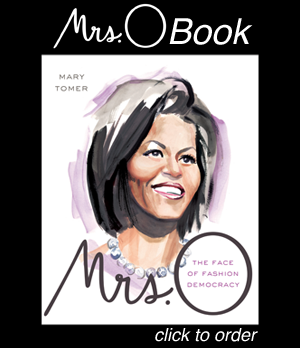If anyone is just tuning in, here's a quick recap of the media frenzy that has ensued over the past 10 days:
The First Lady wore an Alexander McQueen gown to the state dinner to honor President Hu Jintao of China, here. Cathy Horyn of the New York Times and Robin Givhan of The Daily Beast praised the choice, here and here. Oscar de la Renta wondered why Mrs. O wore "European clothes" to WWD, here. WWD's Bridget Foley penned a longer piece with more from Oscar de la Renta, and asked why the CFDA had been silent, here. The CFDA told WWD they were a bit disappointed by Mrs. O's choice, here. Cathy Horyn cut down the CFDA and WWD, supported Mrs. O's right to choose her own dress, and worried that the First Lady won't be known for more than her fashion, here. Then Kate Betts brought things full circle with a New York Times Op-Ed, reinforcing why Mrs. O's fashion is important in the first place, here.
The nine lives of this story, the way it has morphed and grown, so much after the fact, is simultaneously interesting and peculiar. Frankly, I'm a bit tired of it all, and yet, I can't resist from throwing one more opinion into the mix.
Some have commented that they hope Mrs. O doesn't give in to the "political" pressures with regard to her wardrobe, and that she should be able to wear whatever dress or designer she wants. In many ways I agree -- because who are we or anyone to dictate? But at the same time, it feels blind not to acknowledge how much carefully crafted image is wrapped up in Mrs. O's wardrobe already.
J.Crew on The Tonight Show, sunny Isabel Toledo for the inauguration, Naeem Khan for the first state dinner -- these pitch perfect pairings did not happen by accident. All along the way, Mrs. O has used fashion in the smartest, most adept way possible, to the benefit of her public image and attention paid to her core causes. I realize any suggestion that there's calculation in the First Lady's wardrobe will prompt some to cite Mrs. O's statement to Vogue that she wears what she loves. For me, these two notions -- dressing for a public image and wearing what you love -- aren't incongruent.
For this most recent state dinner, it seems Mrs. O chose her dress a bit more for aesthetics, a bit less for symbolism and message. Behind the scenes there are signs of a change in Mrs. O's style advisors, specifically Ikram Goldman, which may have factored into the choice. While the McQueen gown was an expression of fashion freedom, I can't help but wonder: is this media melee worth it? The issue is less the criticism, more the distraction. Simply put: it probably would have been in the First Lady's best interest to wear an American designer.
Now I must circle back to Cathy Horyn's piece, which undoubtedly will spark its own round of debate. Ms. Horyn writes:
Here’s my problem with Mrs. Obama: I want her to be known for something other than her fashion. I want her to be a great first lady who truly cares about the lives of Americans at the time when many need help. I want her to be far more than “prime placement” for a dress label — whatever the country of origin. She supports a number of causes, notably healthful eating habits, but these deeds are being overshadowed by what she wears. Only she can change that perception. In March 2009, The Economist ran an excellent article about our new first lady that expressed the concern that she might become better known for her fashion rather than for her opinions. Unfortunately, that seems to be happening.
Even with what I've just written above, I find this paragraph to be wildly out of touch. For all intents and purposes, the mass media has lost interest in Mrs. O's fashion. Yes, there are stories this week, but on the whole, there are far fewer than there were in 2008 and 2009. This is true even of Cathy Horyn's coverage of the First Lady. (One of Bridget Foley's key points was that in 2011, not all White House appearances are created equal from a fashion perspective.) Lately when Mrs. O is in the news, stories focus on "Let's Move," the White House vegetable garden, and the First Lady's support of military families. The legacy Mrs. O is building will include fashion, but is already far greater.
On that note, I feel compelled to pass along an interesting piece that a reader shared with me this summer. The clipping comes from Annie Dowling, a digital archivist in Fayetteville, Arkansas. The article ran in The Washington Post on November 25, 1981, and was written by Selwa Roosevelt, married to the grandson of Theodore Roosevelt and Chief of Protocol of the United States from 1982-1989. What it shows? That what Mrs. O is up against here is really nothing new.

Note: Click on article to view full scale
Credit: Annie Dowling, Digital archivist, Fayetteville, Arkansas
 Wednesday, February 2, 2011 at 11:15 AM
Wednesday, February 2, 2011 at 11:15 AM  Mrs. T |
Mrs. T |  13 Comments |
13 Comments | 




